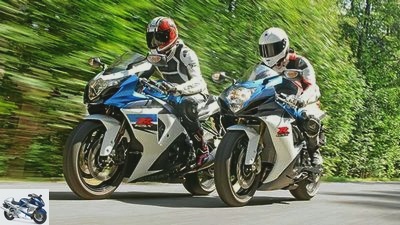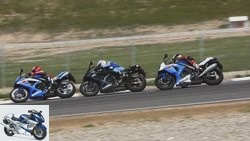Menus
- The super athletes from Suzuki in comparison test
- Technical specifications
- Price comparison for Suzuki GSX-R 750 and Suzuki GSX-R 1000

Rivas
Family duel: Suzuki GSX-R 750 / GSX-R 1000
The super athletes from Suzuki in comparison test
The GSX-R sisters are visually difficult to distinguish from one another. But when driving it turns out that the differences in character are even greater than those in price.
The sound doesn’t make a motorcycle, but it says a lot about its character. This is nice to hear with the two Suzuki immediately after starting. While the 1000s hums powerfully, dull and comfortably from their two mufflers, the 750s barks in bright, hard and loud tones from the single exhaust next to its right swing arm. “Does it only sound like that when you sit on it, or does it sound so aggressive from the outside?” Asked a colleague during the photo drives. The unanimous answer from those gathered at the roadside: “It sounds like that from the outside too.”
The engine characteristics of the 750 series, which can be called “the little one” in this comparison, are corresponding, and the torque curves show that very clearly. While the 1000 is already pushing around the 3000 mark, the 750 still seems a little listless in this area – the curve sags. It is a point of honor for a four-cylinder from Japan that the engine is still powerful enough to swim along in flowing traffic at this speed. It really perks up from around 7500 rpm. At this speed, the 1000 is already in the final ascent to the torque peak, which it reaches 1100 rpm earlier than the 750. And while we’re talking about measured values: In terms of specific torque, i.e. the peak value related to the displacement, the 1000 series with measured 110 to 107 Nm per liter of displacement, while the 750 series leads in the measured liter output with almost 174 to 171 hp.
W.The effect of the torque curve and the noise development of the two GSX-Rs while driving is obvious. Even in the tight bends of the wonderful streets around the Stauferberge in the Swabian Alb, the second gear stays on the 1000, where the 750 needs the first. With all the side effects: The increased switching work, the higher engine braking torque due to the higher speeds, the abrupt changes between acceleration and braking make the 750 series a more strenuous motorcycle despite its superior maneuverability. Her sound characteristics provoke, while the big Gixxer conveys serenity on the country road. To which your downright silky engine running contributes a not inconsiderable part.
Buy complete article

Family duel: Ducati Monster 696 / Monster 1100 Evo
A comparison of Ducati naked bikes
GSX-R 1000 is equipped. To your advantage. In a direct comparison with the 750, the brake on the 1000 responded more quickly.
jkunstle.de; Jacob
Suzuki GSX-R 750.
This statement is of course not set in granite. Depending on whether a brake has already worked in extreme areas on the racetrack or the motorway, how new the pads are or how the minimal distortions in their base plates are, even the quality of identical brake systems can differ from motorcycle to motorcycle.
Despite the difference, both GSX-Rs in this story follow another Suzuki tradition: The standard brake pads only bite cautiously when the load is low and only become more energetic at higher temperatures.
Because the windshield does not rise so high, the driver has to make himself a little smaller when driving on the motorway on the 750 to enjoy a certain wind protection. And possible passengers have it a little more uncomfortable on the back than on the 1000 – they are not really comfortable on either of the two. But nobody would seriously expect that from super athletes of their kind.
In terms of equipment, the only difference between the two GSX-Rs is the carbon coating of the fork sliding tubes on the 1000, while the 750 fork has chrome-plated sliding tubes with a smaller diameter. For 1350 euros less than the 1000 series, the GSX-R 750 is a very attractive offer that, apart from displacement and performance, treats itself to everything that the big one has, from the balance shaft to the anti-hopping clutch and the various engines -Mappings. Even the cockpit has been structurally identical since the most recent revision of the GSX-R 600 and 750.
On the other hand, it should not be concealed here that the 1000 model is about to be replaced and the 2011 model will probably soon be cheaper. Suzuki connoisseurs have already indicated that the new GSX-R 1000 will be revised in the same way as the facelift for the smaller models. Refinements to the engine and weight savings in the range of eight to ten kilograms are to be expected.
CONCLUSION
Those who prefer to drive on the racetrack and don’t have to accept the displacement limits of the Supersport or Superbike class will find the better motorcycle in the aggressively appearing and extremely handy GSX-R 750. The 1000 is more suitable for everyday use and conveys serenity, at least as long as you do not fully exhaust its performance. If you prefer that and are looking for a large GSX-R, you should watch the market next autumn and next spring.

motorcycles
Suzuki GSX-R 600/750/1000
Fisherman’s Friends
read more
Technical specifications
Suzuki GSX-R 1000.
| Suzuki GSX-R 750 | engine |
| design type | Four-cylinder, four-stroke in-line engine | injection | Ø 42 mm |
| coupling | Multi-disc oil bath clutch (anti-hopping) | Bore x stroke | 70.0 x 48.7 mm |
| Displacement | 750 cm3 | compression | 12.5: 1 |
| power | 110.3 kW (150 PS) at 13,200 rpm | Torque | 86 Nm at 11200 rpm |
| landing gear | frame | Bridge frame made of aluminum |
| fork | Upside-down fork, Ø 41 mm | Steering damper | electronic / hydraulic |
| Brakes v / h | Ø 310/220 mm | Assistance systems | – |
| bikes | 3.50 x 17; 5.50 x 17 | tires | 120/70 ZR 17; 180/55 ZR 17 |
| Tires | Bridgestone BT 016 “G” | mass and weight |
| wheelbase | 1390 mm | Steering head angle | 66.4 degrees |
| trailing | 97 mm | Suspension travel v / h | 120/130 mm |
| Seat height ** | 805 mm | Weight with full tank ** | 195 kg |
| Payload ** | 185 kg | Tank capacity | 17.0 liters |
| Service intervals | 6000 km | price | 13140 euros |
| Additional costs | around 195 euros | MOTORCYCLE readings |
| Top speed * | 280 km / h | Acceleration 0-100 km / h | 3.2 sec |
| 0-140 km / h | 4.7 sec | 0-200 km / h | 8.6 sec |
| Pulling speed 60–100 km / h | 4.2 sec | 100-140 km / h | 3.9 sec |
| 140-180 km / h | 4.3 sec | consumption |
| Country road | 4.1 liters / super | Reach country road | 415 km |
| Suzuki GSX-R 1000 | engine |
| design type | Four-cylinder, four-stroke in-line engine | injection | Ø 44 mm |
| coupling | Multi-disc oil bath clutch (anti-hopping) | Bore x stroke | 74.5 x 57.3 mm |
| Displacement | 999 cm3 | compression | 12.8: 1 |
| power | 136.0 kW (185 hp) at 12,000 rpm | Torque | 117 Nm at 10000 rpm |
| landing gear | frame | Bridge frame made of aluminum |
| fork | Upside-down fork, Ø 43 mm | Steering damper | electronic / hydraulic |
| Brakes v / h | Ø 310/220 mm | Assistance systems | – |
| bikes | 3.50 x 17; 6.00 x 17 | tires | 120/70 ZR 17; 190/50 ZR 17 |
| Tires | Bridgestone BT 016 “N” | mass and weight |
| wheelbase | 1405 mm | Steering head angle | 66.2 degrees |
| trailing | 98 mm | Suspension travel v / h | 125/130 mm |
| Seat height ** | 810 mm | Weight with full tank ** | 208 kg |
| Payload ** | 182 kg | Tank capacity | 17.5 liters |
| Service intervals | 6000 km | price | 14490 euros |
| Additional costs | around 195 euros | MOTORCYCLE readings |
| Top speed * | 295 km / h | Acceleration 0-100 km / h | 3.1 sec |
| 0-140 km / h | 4.6 sec | 0-200 km / h | 7.5 sec |
| Pulling speed 60–100 km / h | 3.5 sec | 100-140 km / h | 3.2 sec |
| 140-180 km / h | 3.2 sec | consumption |
| Country road | 5.2 liters / super | Reach country road | 337 km |
* Manufacturer information; ** MOTORCYCLE measurements
Price comparison for Suzuki GSX-R 750 and Suzuki GSX-R 1000
Used Suzuki GSX-R 750 and GSX-R 1000 in Germany
Anyone who is now convinced that they absolutely need a street car from Suzuki should take a look at the used motorcycle exchange. Both the aggressive Suzuki GSX-R750 and the mighty Suzuki GSX-R1000 are available in good condition and at low prices: Used Suzuki GSX-R 750 and Suzuki GSX-R 1000 in Germany
Related articles
-
Suzuki V-Strom 1000 in the top test
fact 26 pictures fact 1/26 First of all, the meticulousness with which Suzuki’s technicians and engineers went to work is surprising. Not just optically …
-
Triumph Daytona 675, Kawasaki ZX-6R 636 and Suzuki GSX-R 750 in the test
fact 20 pictures fact 1/20 super athlete with less than 1000cm³ in the comparison test. Suzuki GSX-R 750, Kawasaki ZX-6R 636 and Triumph Daytona 675. fact 2/20 …
-
Comparison test MV Agusta F3 800 and Suzuki GSX-R 750
21 pictures 1/21 Comparison test MV Agusta F3 800 and Suzuki GSX-R 750. 2/21 Comparison test MV Agusta F3 800 and …
-
Honda Crossrunner and Suzuki V-Strom 1000 in comparison test
fact 30 pictures markus-jahn.com 1/30 Honda Crossrunner and Suzuki V-Strom 1000 in the comparison test. markus-jahn.com 2/30 Honda Crossrunner and Suzuki …
-
Suzuki V-Strom 650 and Suzuki V-Strom 1000 in comparison test
fact 8 pictures fact 1/8 With a torque plateau starting at 3500 rpm, the test bench also demonstrates the punch that dominates the driving impression …
-
Jahn comparison test of supersports: Ducati 998, Honda Fireblade, Kawasaki ZX-9R, Suzuki GSX-R 1000, Triumph Daytona 955i Centennial The K-Question Five …
-
Comparison test sports tourer Kawasaki Z 1000 SX Tourer, Triumph Sprint GT
www. 35 pictures www. 1/35 Sports tourers sit between all chairs, but the temptation lies in this niche: there are bikes, …
-
Comparison test of the 1000 super sports car
Jaime de Diego 38 pictures fact 1/38 Yamaha demands 14895 euros for their completely new R1 super sports car. fact 2/38 Even without ABS, the Fireblade would …
-
Comparison test Honda Fireblade, VTR 1000 SP-2
Artistic comparison test Honda Fireblade, VTR 1000 SP-2 Everything stays different Honda is the only motorcycle manufacturer to produce two 1000cc super sports …
-
Comparison test: high-speed test in Nardo
Jahn 42 pictures Jahn 1/42 Top handling and transparent feedback make the BMW S 1000 RR what it is. She also has a lot of electronic …